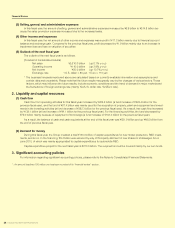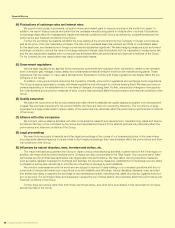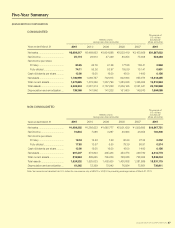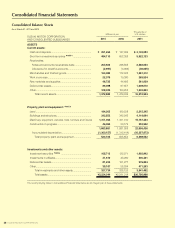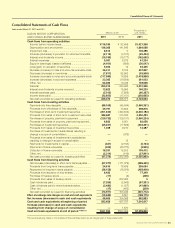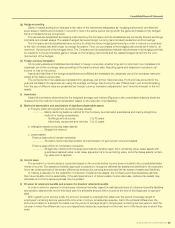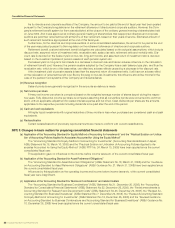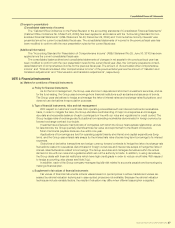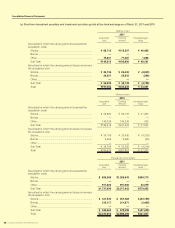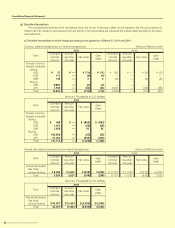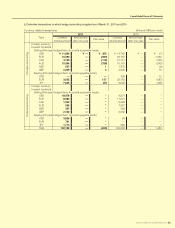Suzuki 2011 Annual Report Download - page 35
Download and view the complete annual report
Please find page 35 of the 2011 Suzuki annual report below. You can navigate through the pages in the report by either clicking on the pages listed below, or by using the keyword search tool below to find specific information within the annual report.
34 SUZUKI MOTOR CORPORATION
Notes to Consolidated Financial Statements
NOTE 1: Basis of presenting consolidated financial statements
The accompanying consolidated financial statements of Suzuki Motor Corporation (the Company) have been prepared on the
basis of generally accepted accounting principles and practices in Japan, and the consolidated financial statements were filed with
the Financial Services Agency as required by the Financial Instruments and Exchange Act of Japan.
The preparation of the consolidated financial statements requires the management to select and adopt accounting standards and
make estimates and assumptions that affect the reported amount of assets and liabilities, revenue and expenses, and the corre-
sponding methods of disclosure.
As such, the management’s estimates are made reasonably based on historical results. But due to the inherent uncertainty in-
volved in making estimates, actual results could differ from these estimates.
For the convenience of readers outside Japan, certain reclassifications and modifications have been made to the original consoli-
dated financial statements.
As permitted, an amount of less than one million yen has been omitted. For the convenience of readers, the consolidated financial
statements, including the opening balance of shareholders’ equity, have been presented in U.S. dollars by translating all Japanese
yen amounts on the basis of 83.15 to U.S.$1, the rate of exchange prevailing as of March 31, 2011. Consequently, the totals shown
in the consolidated financial statements (both in yen and in U.S. dollars) do not necessarily agree with the sum of the individual
amounts.
NOTE 2: Summary of significant accounting policies
(a) Principles of consolidation
The consolidated financial statements for the years ended March 31, 2011 and 2010, include the accounts of the Com-
pany and its significant subsidiaries and the number of consolidated subsidiaries are 138 and 138 respectively. All significant
inter-company accounts and transactions are eliminated in consolidation. Investments in affiliated companies are accounted
for by the equity method.
The difference at the time of acquisition between the cost and underlying net equity of investments in consolidated subsid-
iaries and in affiliated companies accounted for under the equity method (goodwill) is, as a rule, amortized on a straight-line
basis over a period of five years after appropriate adjustments.
The account settlement date of 31 consolidated subsidiaries is December 31, but Magyar Suzuki Corporation Ltd. and 4
others are consolidated based on the financial statements of provisional account settlement as of March 31. Other 26 subsid-
iaries are consolidated with the financial statements based on their respective account settlement date.
The account settlement date of other consolidated subsidiaries is the same as the consolidated account settlement date.
(b) Allowance for doubtful receivables
The allowance is appropriated for an estimated uncollectible amount into this account based on doubtful receivable ratio
for general receivables and the identified collectability for specific receivables.
(c) Provision for warranty costs
The provision is appropriated into this account based on the warranty agreement and past experience in order to allow for
expenses related to the maintenance service of products sold.
(d) Provision for recycling end-of-life products
The provision is appropriated for an estimated expense related to the recycling end-of-life products of the Company based
on actual sales.
(e) Provision for product liabilities
With regards to the products exported to North American market, to prepare for the payment of compensation, not cov-
ered by “Product Liability Insurance” the anticipated amount to be borne by the Group is computed and provided on the basis
of actual results in the past.
(f) Short-term investment securities and Investment securities
The Company and its subsidiaries hold securities of listed companies, which have a risk of price fluctuations, and non-
listed companies whose stock prices are difficult to be evaluated.
If we judge the decline in investment value is not temporary, we recognize revaluation loss based on the reasonable stan-
dard. If the stock market falls, we may incur significant loss on valuation of securities.
Securities have to be classified into four categories: trading securities; held-to-maturity debt securities; investments of the
Company in equity securities issued by consolidated subsidiaries and affiliates; and available-for-sale securities.
According to this classification, securities held by the Company and its subsidiaries are available-for-sale securities.
Available-for-sale securities for which market quotations are available are stated at market value method based on the market
values as of the consolidated account settlement date (The evaluation differences shall be reported as a component of net as-
sets, and sales costs shall be calculated mainly by the moving average method).
Available-for-sale securities for which market quotations are unavailable are stated at cost by a moving average method.
Consolidated Financial Statements


